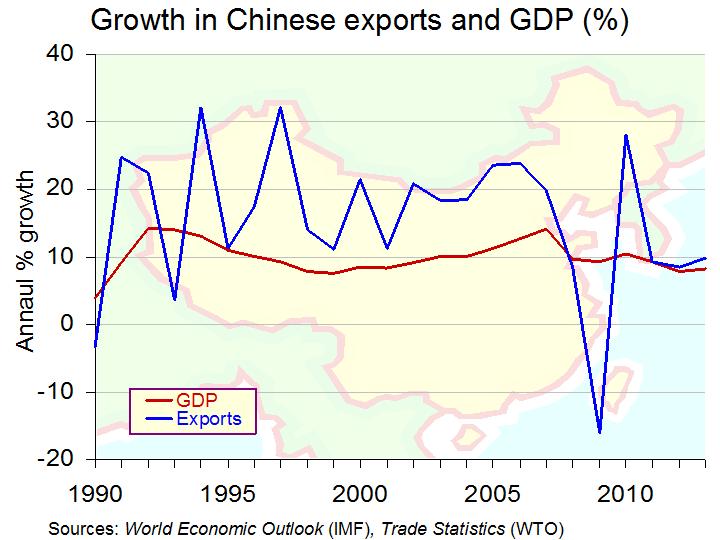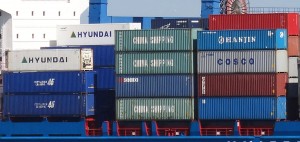 China has been one of the success stories of the past 20 years, with rapid growth in domestic and export demand. This has created the second largest economy in the world. From 1992 to 2007 annual GDP growth averaged 10.7% and annual export growth averaged 18.9% (see chart).
China has been one of the success stories of the past 20 years, with rapid growth in domestic and export demand. This has created the second largest economy in the world. From 1992 to 2007 annual GDP growth averaged 10.7% and annual export growth averaged 18.9% (see chart).
However, with the credit crunch and ensuing recession, growth rates in China have fallen somewhat. Annual GDP growth has averaged 9.6% and annual export growth has averaged 7.4%. Such growth rates may not seem bad, given that many Western economies have been struggling to achieve any growth, but they have been causing concern for this booming economy.
 In its May Outlook, the World Bank forecast China’s growth for the year at 8.2%, but it has since been reduced to 7.8%. A key part of China’s success story has been its export market, but it has been this market that has caused concerns for the mainland economy. In August of this year, its year-on-year export growth was at only 2.7%, but exports last month grew by more than expected, at approximately 7.4%. China has had a consistent trade surplus and according to government figures, this has widened to $27.67 billion in September from $26.66 billion in the previous month.
In its May Outlook, the World Bank forecast China’s growth for the year at 8.2%, but it has since been reduced to 7.8%. A key part of China’s success story has been its export market, but it has been this market that has caused concerns for the mainland economy. In August of this year, its year-on-year export growth was at only 2.7%, but exports last month grew by more than expected, at approximately 7.4%. China has had a consistent trade surplus and according to government figures, this has widened to $27.67 billion in September from $26.66 billion in the previous month.
Recovery in this market will be crucial for the continued success of the economy, as a means of alleviating the fears of a slowdown. This higher growth of exports may be a misleading indicator, perhaps influenced by seasonal factors and thus may not be a sign of what’s to come. Indeed, many analysts have said that they are not convinced that these healthier trade figures will remain. Alistair Thornton, from IHS Global Economics said:
“It’s safe to say we are overshooting the trend here and we expect (the data) to come back in line in the months ahead.”
Citigroup economist, Ding Shaung also confirmed these sentiments:
”The trade data is a positive sign for the Chinese economy … But it remains to be seen whether import and export growth can remain at these levels.”
Part of this pessimism is due to the uncertainty surrounding the growth prospects of its biggest two trading partners – the US and the European Union. Exports to the former have remained relatively high, but exports to the European Union have suffered, falling by over 5.6%. It is likely that weaknesses in the global economy have held back China’s growth prospects in both exports and national output. The Chinese government was aiming for growth of 7.6% in 2012. Not a bad rate you may say, but when compared with growth rates for 2011 (9.3%) and 2010 (10.4%), it does represent a significant fall. The future of the Chinese economy is crucial for the recovery of the world economy, in part as it represents a big demand for imports from other countries, such as the US and Europe. The following articles consider the trade and growth prospects of the world’s second largest economy.
Chinese exports grow faster than expected in September BBC News (14/10/12)
Chinese exports grow faster than expected Financial Times, Patti Waldmeir (14/10/12)
China exports jump, but weaknesses seen ahead The Korea Herald (14/10/12)
China exports rise, hinting at a glimmer of revival New York Times, Keith Bradsher (13/10/12)
China’s trade surplus widens Wall Street Journal, William Kazer (13/10/12)
Chinese surplus widens as exports surge CNN, Paavan Mathemas (13/10/12)
 China’s economic slow-down BBC Today Programme, Linda Yueh (18/10/12)
China’s economic slow-down BBC Today Programme, Linda Yueh (18/10/12)
Questions
- What is a trade surplus?
- Which factors have influenced Chinese exports and imports?
- Why is China’s growth rate such an important variable for the UK and other Western economies?
- Why has export growth in China fallen recently? Can you use the same explanation for its lower growth in national output?
- Explain why analysts remain pessimistic about the sustainability of these improved trade figures.
- Using a diagram, illustrate the effect that higher Chinese growth rates will have on GDP in a country such as the UK. Could there be a multiplier effect?
 For some people, a pint of beer is a regular thing each week. Add all your pints of beer together, then add your friend’s pints, their friends’ pints and … you get the idea. Once you’ve done that for the entire population, you have an estimate of total beer consumption in the UK. This can then be compared with total consumption of beer in other countries and between continents.
For some people, a pint of beer is a regular thing each week. Add all your pints of beer together, then add your friend’s pints, their friends’ pints and … you get the idea. Once you’ve done that for the entire population, you have an estimate of total beer consumption in the UK. This can then be compared with total consumption of beer in other countries and between continents.
Prior to 2007, Europe and the Americas were the biggest beer drinking continents, but since then, Asia has emerged as the leader of pints of beer consumed, drinking 67bn litres of beer compared with the Americas’ 57bn and Europe’s 51bn in 2011. In per capita terms, Asia is still some way off, with Japan leading the way as the highest Asian country in 41st place, consuming 64 litres of beer per year per capita of the population. So how is this relevant to economics and business?
 Consumption of anything provides jobs – bar workers, manufacturers and in the case of beer, probably law enforcement! It probably also increases utility – after all, why consume it if it’s not going to give you some degree of satisfaction!
Consumption of anything provides jobs – bar workers, manufacturers and in the case of beer, probably law enforcement! It probably also increases utility – after all, why consume it if it’s not going to give you some degree of satisfaction!
We can analyse the demand for beer and see how it varies with changes in price and income. Minimum prices for alcohol have been proposed as a means of reducing consumption, and tax and excise duties are always linked to alcoholic beverages and clearly have an effect on demand. In this case, however, we can also consider the emergence of Asia and how tastes have changed. It is the fastest growing beer market in the world; so what can we deduce from that? As the BBC News article states, it is ‘a sign of a young, upwardly mobile, and increasingly hedonistic population.’
Experts also say that the increased consumption of beer in Asian countries is closely correlated with growing incomes and prosperity. A consumer research analyst from Standard Chartered, Nirgunan Tiruchelvam, said:
“Beer has a clearer correlation with strong economic growth … People tend to drink beer in times of growth. They drink spirits when times are good and when times are bad.”
Data suggest that when a certain level of prosperity is reached in a nation, beer sales begin to rise. As many Asian economies begin to develop rapidly, beer sales have taken off. This could be regarded as a good thing for Europe. With stagnant Western economies, beer producers within Europe may be grateful for a growing demand in Asia. Indeed, many of the world’s biggest breweries are expanding rapidly, providing jobs and income. Consumers in Europe will also be happy to see that beer production remains profitable in other parts of the world. With unemployment still high and recession ongoing, a pint of beer will be a much needed pick-me-up for many people. At least, that’s what the evidence from the Great Depression of the 1930s suggested!!
It’s not good news for everyone, however. Beer production has also increased in Asian countries, most notably in China, which now leads the world as the largest beer producer. This clearly reduces the export potential for European beer producers.
Also, many argue that the growing consumption of beer in Asia is simply an illustration of growing Western influence and it is likely to create severe medical problems in the future. Binge drinking and under-age consumption is already a big problem in Western countries and this could soon begin to extend across the world. The following articles consider the growth in consumption of beer.
Brewers thirsty for expansion as taste for beer grows in emerging markets Guardian, Simon Neville (3/9/12)
Beer in Asia: the drink of economic growth BBC News, Saira Syed (6/9/12)
Study says world beer production hits new high Long Island Business News, Associated Press (8/8/12)
Global beer sales go up for 27th year running News Track India (9/8/12)
Questions
- Use a supply and demand diagram to analyse recent trends in beer consumption across the world.
- Which factors have caused demand in emerging markets to increase? Based on your answer to the previous question, how might that have affected equilibrium prices?
- How has growth in beer consumption throughout Asia benefited Western producers?
- What would you expect the price and income elasticities of demand to be for a product such as beer? Explain your answer.
- To what extent do you think this trend in beer production is a sign of globalisation?
- Evaluate the extent to which the growth in consumption and production of beer in Asia is a good thing. You should consider everyone who and everything might be affected!
 With globalisation, more and more businesses have found it beneficial to ‘go global’. There are many reasons why a firm might choose to expand its production or market to other countries and one particular advantage is cutting costs in the manufacturing of products.
With globalisation, more and more businesses have found it beneficial to ‘go global’. There are many reasons why a firm might choose to expand its production or market to other countries and one particular advantage is cutting costs in the manufacturing of products.
Countries such as China and India have become leaders in production. Look at many of the items you own – I’m sure you’ll see a ‘Made in China’ or ‘Made in India’ amongst them. These fast emerging countries were highly sought after as places to produce due to much cheaper production costs. This advantage led to Western companies outsourcing much of their manufacturing base to China, as a means of retaining a competitive advantage.
However, the cost advantages that China boasted are now less significant and we may be about to see the emergence of a new manufacturing hub. Other countries that are further behind the BRICS in the development process now have cost advantages over places like China and so we may see another transfer of manufacturing to other parts of the world.
 When splitting up a supply chain to gain cost advantages a key consideration is the extent to which you lose control. Communication and co-ordination issues can emerge when design takes place in one country; production in another and then the products are sold around the world. When cost differences are huge, these problems can be overlooked, as what they might cost you in terms of lost time etc. is easily made up by savings through cheaper labour.
When splitting up a supply chain to gain cost advantages a key consideration is the extent to which you lose control. Communication and co-ordination issues can emerge when design takes place in one country; production in another and then the products are sold around the world. When cost differences are huge, these problems can be overlooked, as what they might cost you in terms of lost time etc. is easily made up by savings through cheaper labour.
However, when the cost advantages of production in China shrink, companies are still left with the problems of communication and co-ordination. These now represent more significant costs that could be reduced were production to revert to the country of design or if production were to be moved to an even cheaper country.
The following article from BBC News considers the issues surrounding the supply chain and how businesses may benefit from more collaboration.
Better collaboration lets businesses take back the supply chain BBC News, Alastair Sorbie (15/6/12)
Questions
- What are the arguments for becoming a multinational?
- Why do host countries, such as the BRICS accept inward investment? What do they gain from it?
- Explain how the product life cycle can affect the profitability of a MNC and how the company might respond.
- What are the disadvantages to a MNC from ‘going global’?
- What are the problems faced by developing countries acting as host nations?
- How has technology affected both big and small businesses?
The two biggest world exporters have signed trade deals worth $15bn (£9bn). The Chinese Premier and German Chancellor were targeting an increase in bilateral trade to £178bn over the next five years. Premier Wen has also offered support to some of the European countries struggling with their debt. Despite this offer of support, there is something in it for the Chinese economy. China’s foreign exchange reserves are at a record high, but about 25% are invested in euro-denominated assets, hence China has a very strong interest in preventing the collapse of the euro. Furthermore, it is also interested in diversifying its export market to reduce its reliance on US markets. This is particularly important given the growth in protectionism in the US economy. Mr. Innes-ker said:
“China’s dependence and exposure to the US dollar creates issues for its own economy to the extent that it’s a hostage to US monetary policy.”
China’s interest in the European economies may provide an opportunity for the UK economy, as it is a country with ideal investment conditions and is already one of China’s most important trading partners. David Cameron, in a meeting with Wen, has said he wants bilateral trade to increase to £62bn by 2015. The amount is nothing in comparison to the trade deal between China and Germany, but still a significant potential sum for the UK economy. The following articles consider the Chinese economy and its role in the global environment.
Self-interest in China’s helping hand Asia Times Online, Jian Junbo (30/6/11)
China and Germany ink $15bn trade deals as leaders meet BBC News (29/6/11)
Chinese leader’s visit to Germany ends with large trade deals The New York Times, Judy Dempsey (28/6/11)
China offers helping hand to Eurozone Guardian, Helen Pidd (28/6/11)
Rights, trade to dominate Germany-China talks Associated Press, Deborah Cole (28/6/11)
China promises EU ‘helping hand’ with debt crisis Reuters, James Pomfret and Stephen Brown (28/6/11)
We still don’t grasp how little we matter to China Independent, Hamish McRae (29/6/11)
Questions
- What are the benefits of trade?
- Why is it important for the Chinese economy to diversify its export market?
- What does it mean by the statement that China is hostage to US monetary policy?
- Why are China’s foreign exchange reserves at a record high?
- What are the reasons behind China’s interest in Europe? Is it more of a ‘helping hand’ or more to do with furthering China’s own ambitions?
- What might the trade deal between China and Germany mean for trade between China and other nations? Is the deal to the benefit of everyone?
In January 2011, Chinese growth accelerated to 9.8% as industrial production and retails sales picked up. As the second largest economy, this very high growth is hardly surprising, but it has caused concern for another key macroeconomic variable: inflation. Figures show that inflation climbed to 5.2% in March from a year before and the billionaire investor George Soros has said it is ‘somewhat out of control’. High property and food prices have contributed to high and rising inflation and this has led to the government implementing tightening measures within the economy.
In March, growth in property prices did finally begin to slow, according to the survey by the National Bureau of Statistics. Prices of new built homes had risen in 49 out of 70 Chinese cities in March from the previous months, but this was down from 56 cities in February. A property tax has also been implemented in cities like Shanghai and the minimum down payment required for second-home buyers has risen in a bid to prevent speculative buying. Bank reserve requirements have also been increased for the fourth time, after an increase in the interest rate at the beginning of April. The required reserve ratio for China’s biggest banks has now risen to 20.5%.
The situation in China is not the only country causing concern. Inflation in emerging markets is a growing concern, especially for the richer nations. The Singaporean finance minister, Tharman Shanmugaratnam, said:
“When inflation goes up in emerging markets, it’s not just an emerging market problem, it’s a global inflation and possibly interest rate problem … We have learned from painful experience in the past few years that nothing is isolated and that risk in one region rapidly gets transmitted to the rest of the world.”
He has said that inflation in emerging markets needs addressing to ensure that it does not begin to threaten the economic recovery of other leading economies. The following articles consider the latest Chinese developments.
New home price growth dips amid government tightening BBC News (18/4/11)
China growth may cool in boost for Wen’s inflation campaign Bloomberg Business (14/4/11)
China steps up inflation fight with bank reserves hike Independent, Nikhil Kumar (18/4/11)
China raises bank reserves again Reuters (17/4/11)
 China’s economy ‘is just too hot’ says Peter Hoflich BBC News (18/4/10)
China’s economy ‘is just too hot’ says Peter Hoflich BBC News (18/4/10)
Top G20 economies face scrutiny over imbalances AFP, Paul Handley (16/4/11)
Inflation in China poses big threat to global trade Global Business, David Barboza (17/4/11)
Chinese inflation to slow to 4% by year-end: IMF AFP (17/4/11)
Chinese economic growth slows but inflation soars Guardian, Tania Branigan (15/4/11)
Questions
- What type of inflation is the Chinese economy experiencing? Explain your answer using a diagram.
- To what extent will the minimum payment on second homes and the property tax help reduce the growth in Chinese property prices?
- Why is there concern about high inflation in emerging markets and the impact it might have on other countries?
- How could the inflation in China hurt the economic recovery of countries such as the UK?
- How will the increase in the banks’ reserve requirements help inflation?
- Is high Chinese growth and high inflation the relationship you would expect to occur between these macroeconomic objectives? Explain your answer.
 China has been one of the success stories of the past 20 years, with rapid growth in domestic and export demand. This has created the second largest economy in the world. From 1992 to 2007 annual GDP growth averaged 10.7% and annual export growth averaged 18.9% (see chart).
China has been one of the success stories of the past 20 years, with rapid growth in domestic and export demand. This has created the second largest economy in the world. From 1992 to 2007 annual GDP growth averaged 10.7% and annual export growth averaged 18.9% (see chart). In its May Outlook, the World Bank forecast China’s growth for the year at 8.2%, but it has since been reduced to 7.8%. A key part of China’s success story has been its export market, but it has been this market that has caused concerns for the mainland economy. In August of this year, its year-on-year export growth was at only 2.7%, but exports last month grew by more than expected, at approximately 7.4%. China has had a consistent trade surplus and according to government figures, this has widened to $27.67 billion in September from $26.66 billion in the previous month.
In its May Outlook, the World Bank forecast China’s growth for the year at 8.2%, but it has since been reduced to 7.8%. A key part of China’s success story has been its export market, but it has been this market that has caused concerns for the mainland economy. In August of this year, its year-on-year export growth was at only 2.7%, but exports last month grew by more than expected, at approximately 7.4%. China has had a consistent trade surplus and according to government figures, this has widened to $27.67 billion in September from $26.66 billion in the previous month. China’s economic slow-down BBC Today Programme, Linda Yueh (18/10/12)
China’s economic slow-down BBC Today Programme, Linda Yueh (18/10/12)


